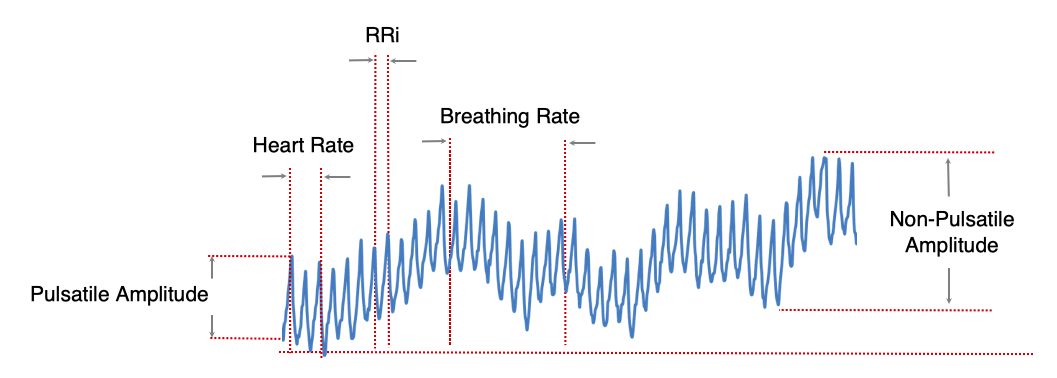What are biometric parameters and why do they matter?
Biometric parameters are the hidden gems found in leading biometric sensor technology that don’t get much attention but hold a great deal of potential for next-generation wearables and hearables. As background, one of the reasons PPG sensor technology has come to dominate the market for biometric sensors in wearables is that the PPG waveform can provide a broad range of insights on blood flow characteristics beyond simple heart rate measurement. This in turn enables a rich set of biometric measures, including continuous heart rate, R-R interval (heart rate variability), VO2 max, cardiac efficiency, blood pressure, and more.
But wait there’s more…the “metadata” about the PPG signal (what Valencell calls Biometric Parameters) can provide important contextual information for advanced use case development. The graphic below shows these biometric parameters overlaid on a simplified PPG waveform produced by Valencell sensors.

So let’s take a closer look at each of these biometric parameters:
- Signal Quality Indicator – This patented indicator provides a second-by-second numerical value of the quality of the incoming PPG signal on a scale of 1-100. If this number is above a certain threshold, it confirms whether the Valencell sensor is locked on to blood flow. The signal quality indicator identifies “good data” and “bad data”, enabling wearable devices to identify the “bad” and keep the “good”, which not only improves accuracy but also ensures users of the data can be confident in the data quality.
- Normalized Pulsatile Amplitude – This ratio will provide an indication of blood volume, which enables estimations of ambulatory blood flow characteristics which are an important indicator of how efficiently the heart can meet the body’s demands. Some examples of these characteristics include perfusion, pulse pressure, blood oxygenation, and cardiac output (total volume/minute).
- Non-Pulsatile Amplitude – This is an indication of the non-pulsatile component of the light signal, which is useful in calculating biometric assessments such as respiration characteristics.
- Ambient Light Average – This is an estimate of the ambient light exposure which can provide users with insight into how much time they spend indoors vs. outdoors.
- Activity Categorization – In addition to step count and cadence, this categorization identifies whether the body is walking, running, or experiencing a sudden change in position such as fall detection or a burst of acceleration like sprinting. This categorization helps provide a more accurate summary of activity and helps quantify the intensity of activity.
Why do biometric parameters matter?
First, you can develop new use cases based on PPG sensors. Most PPG-based devices today measure heart rate and potentially a few other metrics like heart rate variability, sleep, or stress. Biometric parameters enable device makers to build new use cases in two categories:
- New devices to address existing use cases. Valencell’s development of PPG-based blood pressure measurement is a good example. The market need and user experience for blood pressure is well-established, but enabling the measurement of blood pressure in a phone or earbud opens up new possibilities, such as continuous monitoring of blood pressure.
- Using biometric parameters as a research vector for entirely new use cases. For example, using normalized pulse amplitude to quantify pulse pressure in the context of heart rate dynamics could lead to new insights, particularly for managing specific diseases or medical conditions.
Second, biometric parameters provide confidence in data quality for user experiences and user interfaces. Far too many devices simply report the heart rate number, regardless of the quality of the signal. If a user can’t trust the data coming from a device, the device loses much of its value. With Signal Quality Indicator, device makers and researchers can know when the data is trustworthy and when NOT to use data coming from poor signal quality. This is particularly important in health and medical use cases, where the data can be used to guide treatment decisions.
Third, biometric parameters reduce the need for other sensors and solutions. For example, the ambient light average can provide insight into overall sunlight exposure, not only enabling a new use case, but leveraging the photodetector in the PPG sensor for other purposes. Similarly, the activity categorization uses the accelerometer in the PPG sensor system to categorize different activities. That raw accelerometer data can also be used for other purposes, such as creating a fall detector, without the need for an additional sensor.
For additional information on this topic, please check out the presentation below.
We are always interested in exploring new use cases for PPG sensors. If you think biometric parameters could be valuable for your project, please reach out to us at [email protected].